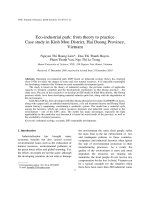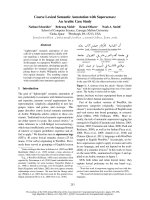WAN multi zone case study.doc
Bạn đang xem bản rút gọn của tài liệu. Xem và tải ngay bản đầy đủ của tài liệu tại đây (26.04 KB, 5 trang )
chapter 9:
WAN multi zone case study
this section will give you an example of a typicacal WAN multi zone model
deployed in an enterprise WAN environment.
this chapter contains the following sections:
• overview
• network layout
• network design
• dial plan
• video intrastructure
overview:
in this case study the customer is a health care provider with locations across
the united states. there are five locations that are currently using ISDN based
videoconferenc. the customer has a T1 to cach site and would like to install
new H.323 videoconferencing units and utilize their existing WAN
bandwidth. each site contains a minimum of three video units and the
customes has standardized on 384k as their call data rate. the customer
requires multipoint calls as well as the ability to call off net to their cutomers.
network layout:
currently the customer has five sites in the united states consisting of
sacramento CA, L os Angeles CA, dallas TX, columbus OH, and chicago IL.
each site is conect back to columbus OH with a T1 and bandwidth utilization
on all of the connections id fairly low. the customer has just upgraded their
WAN routers at remote sites to 3640’s to spport voice video and data in the
near future. currently all videoconferencing units are directly connected to an
IMUX with three BRI lines allowing boded 384k calls. the columbus site
contains an H.320 multipoint conference unit(MCU) with three PRI lines
supporting multipoint calls among the sites. figure 9-1 illustrates the
cutomers IP network and figure 9-2 illustrates the cutomer’s current
videoconferencing network.
network design:
the network outlined above is a classic WAN multi zone model, there is
sufficient WAN bandwidth and each site contains three or more video
terminals. in this network a gatekeeper and proxy will be located at each site.
directory gatekeeper services will be configured and HSRP will be used for
gatekeeper redundancy at the columbus site. there are two key elements that
will need to be configured in the network to ensure video quality.
• quality of service
• call admission cotrol
quality of service
end to end QoS is a key factor to a successful deployment. the customer has
decided to go with an H.323 video terminal that supports marking of IP
precedence. columbus, sacramento and dallas have just upgraded their
switches to catalyst 6500’s. in these two sites LAN QoS will be configured
the other three sites will support LAN QoS when the switches at those sites
are upgraded. all video units will be connected to 10/100 ethernet ports.
all video terminals will be configired to mark IP precedence 4. in columbus,
sacramento and dallas trust boundaries will be set on the catalyst 6500
awitches. video gateways and MCUs will also be installed in columbus,
sacramento and dallas. at this time gateways and MCUs don’t support IP
precedence. IP precedence will be marked and a trust boundary will be set on
the catalyst 6500 ports that the gateways and MCUs are connected to.
gateways will also be intralled in los angles and chicago.
priority queues will be configured on all WAN routers and be provisioned for
920k. this will guarantee that bandwidth is available for two 384k calls. an
access list entry will also be added on the WAN router setting the entrance
criterion for the priority queue. only video traffic received from the proxy
will be admitted to the priority queue.
the gatekeeper at each site will be configured to use the local proxy for all
inter zone calls. the proxy will rewrite IP precedence 4 and provide a single
access point to the configured priority queue.
for more information regarding network QoS refer to the AVVID QoS design
guide at.
/>.html
call admission control
call admission control(CAC) must be implemented for inter zone calls. it is
also a good idea to configure CAC for intra zone calls . setting CAC on for
inter zone calls guarantees that the provisioning on the priority queues will
not be exceeded. if the provisioned bandwidth for the priority queue on the
WAN route is exceeded all video calls in the queue will be effected. the
gatekeeper at each site will contain three bandwidth statements for CAC.
1> bandwidth total default<bandwidth> 2> bandwidth remote 1536
bandwidth section default 768 .it is important to note that the bandwidth is
calculated in half duplex, so the call data rate must be doubled . a 384k call
is represented as 786 in the bandwith statements. with the three-bandwidth
statements above we have limited the total bandwidth in the local zone (to a
number yet to be decided). limited the remote bandwidth (available
bandwidth to and from any remote zone) to 1536, or two 384k calls. the
bandwidth per secsion has been limited to 768 or 384k. figure 9-3 illustrates
QoS and CAC points for columbus, figure 9-4 illustrates QoS and CAC point
for dallas and sacramentto and 9-5 illustrates QoS and CAC point for Los
Angeles and chicago.
dial plan
when deciding on a dial plan it is always a good idea to start with incoming
PSTN call routing. in our example we have created five zones that all contain
video gateways. DID will be used to route incoming calls to video terminals.
IVR will be used to route calls from the video gateways in columbus, dallas
and sacramento their local MCUs. If for some reason one or more of the
zones in our example did conain a gateway IVR for all-incoming PSTN
routing would have beeb a better choice.
zone prifexesthe zone prifex for each zone is based on the local area code.
area codec are unique and user are familiar with the number structure. in our
configuration there is single zone in each site so the zone prifexes will be
based on the area codec. If more than one zone were required in a single area
code longer zone prifexes could be used (see zone prifex design in chapter 6).
the zone prifexes in this network are.
columbus = 614
sacramento = 916
dallas = 972
chicago = 847
los angeles = 213
video infrasture:
when deciding on location and number of video components it is inpoetand
the customer’s needs. this customer made it clear that less than ten perent of
video calls placed were off net calls. the number of video calls placed daily
ranges from 10 to 15 and most calls are multipoint. for this t\reason the
customer decided to go with video gateways at each site, and MCUs in
columbus, dallas and sacramento. below the video components for each site
are covered
columbus
* IP video terminals 24
the current 24 H.323 video systems areover three years old and will be
replaced with new H.323 group systems that support IP precedence
• MCUs 4
the four MCU’s will be configured in a stack allowing one set of service
prifexes to be shared by all four MCU’s
* video gateway’s PRI 1
a single PRI gateway will be intalled with 30 DID numbers that will be
assigbed to the IP video terminals. all 10 digit will be passed to the gateway
by the carrier, allowing each video terminal to register with a 10 digit fully
qualifier E.164 address. IVR will be enable and used for PSTN access to
MCU conferences. one DID number will need to be reserved for IVR calls.
sacramento
• IP video terminal
the existing 6 H.323 video systems are over three years old and will be
replaced with new H.323 group systems that support IP precedence.
• MCU
a single MCU will be located on the sacramento campus for local on site
multi calls. the sacramento campus is in the process of adding another
building and possibly adding two or three additional IP video terminal.
the MCU will also allow multiple video terminals to perticpate in an off
campus multpoint call while only consuming the bandwidth of a single
call. this will be done by cascading a sacramento MCU conference with a
columbus MCU conference.
* video gateway
a single PRI gateway will be intalled with 30 DID numbers that will be
assigbed to the IP video terminals. all 10 digit will be passed to the gateway
by the carrier, allowing each video terminal to register with a 10 digit fully
qualifier E.164 address. IVR will be enable and used for PSTN access to
MCU conferences. one DID number will need to be reserved for IVR calls.
dallas
• IP video terminals 10
the existing 10 H.323 video systems are over three years old will be replaced
with new H.323 group systems that support IP precedence.
• MCU
a single MCU will be located on the dallas campus for local on site multi
point calls. the MCU will also allow multiple video terminals to particpate
in an off campus multipoint call while only consuming the bandwidth of
a single call. this will be done by casading a dallas MCU conference with
a columbus MCU conference.
* video gateway
a single PRI gateway will be intalled with 30 DID numbers that will
be assigbed to the IP video terminals. all 10 digit will be passed to the
gateway by the carrier, allowing each video terminal to register with a 10
digit fully qualifier E.164 address. IVR will be enable and used for PSTN
access to MCU conferences. one DID number will need to be reserved for
IVR calls.
los angeles
• IP video terminals
the existing 4 H.323 video systems are over three years old will be replaced
with new H.323 group systems that support IP precedence.
• MCU
los angeles will not have a local MCU.
• video gateway
asingl BRI gateway will be installed with four BRI lines . each video
terminal will receive a DID number from one of the BRI lines. IVR will
not be enable on the gateway.
chicago
• IP video terminals
the existing 3 H.323 video systems are over three years old will be replaced
with new H.323 group systems that support IP precedence.
• MCU
chicago will not have a local MCU.
• video gateway
asingl BRI gateway will be installed with four BRI lines . each video
terminal will receive a DID number from one of the BRI lines. IVR will
not be enable on the gateway.
figure 9-7 illustrates the video components and dial plan for the new IP
video network.









